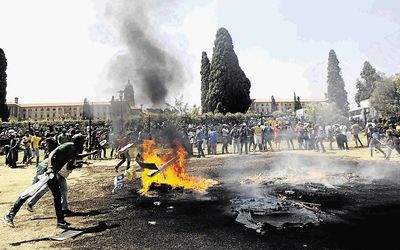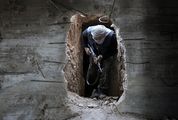HALF ART: Arson fires up art and struggle disputation
by Chris Thurman,
2016-02-26 06:06:31.0
AS I wrote my column last week, the deadlock between protesting students and executives at the University of Cape Town (UCT) was morphing into violent conflict: defaced statues, burnt paintings, burnt vehicles, rubber bullets, tear gas, arrests. But once the smoke had cleared, the causes of these effects remained uncertain.
Was this the consequence of managerial intransigence — over the accommodation question, over academic and financial exclusion, over campus semiotics (ignoring the signs and symbols that, as relics of a segregated past, are seen by many as a visual manifestation of resistance to institutional transformation)?
Or was it that a small number of students, impatient and desperate, dazzled by the glamour of revolutionary fervour, crossed the line separating principled protest from vandalism and thuggery?
Well, it was neither. Or both. The problem, as commentators such as Sisonke Msimang have noted, is that responses to the event indicate a tendency to want to see things in clear-cut, black-and-white, right-and-wrong terms. We pick a stance and stick to it. Condemning the burning of paintings means condemning the #RhodesMustFall movement; defending the actions of protesters means calling for the arrest of vice-chancellor Max Price.
Things aren’t that simple. Of course, such complexity also makes it easy for people such as me to sit perpetually on the fence. So, although it’s old news now — having been eclipsed first by racial antagonism between black activists and white reactionaries at the universities of Pretoria and the Free State, and then by acts of arson at North-West University (NWU) — let me venture some thoughts about painting-burning, beyond the few sentences included in last week’s column. I presented the eruption at UCT as an instance of the failure of dialogue on the very site, a university campus, where one should be most hopeful of its success.
City Press subsequently published parallel accounts by deputy vice-chancellor Francis Peterson and Rhodes Must Fall member Wanelisa Albert that served only to confirm the two not only have diametrically opposed interpretations of events, but barely seem to share the same language.
Small wonder that dialogue is impossible.
At this point, visual arts practitioners would typically claim some transcendent or mediating power for their craft: a work of art doesn’t depend on language, or at least is not limited to one language, and can, therefore, "escape" linguistic constraints; it simultaneously accommodates multiple opposing interpretations. But such discussions operate at a theoretical level, assuming the artwork as revered object. They cannot take place if an angry protester views a painting a priori as the irredeemably tainted product of an oppressive colonial history.
In a curious fusion of art theory and the will-to-destroy, Andile Mngxitama went so far as to suggest that the burning of works by black artist Richard Baholo was not simply collateral damage, but an act that "liberated" Baholo — presumably because his art had been co-opted by UCT’s "white establishment". It seems that Baholo has no say in this matter (a Mail & Guardian headline indicated he "supported" the students, although this was not borne out in an interview with him).
Abstract discussions about the "meaning" of a work of art not residing with the artist may be interesting, but cannot justify the burning of a painting. And while there are solid grounds to critique the commodification of art, or the complicity of artists with the politics of those who commission their work, or the elevation of art works and their (dead) subjects above the plight of poor (living) students, there is something perverse in taking pleasure from a pyre of canvas and wood and glass — revelling in burning as spectacle.
Fire has strong resonances with SA’s struggle past and with more recent protests. But it is troubling when this already morally ambiguous image is fused with the idea of being "on fire" like a performer on stage, or being "lit" like a party (it can also refer to intoxication), or being "burned" by a verbal put-down. All of these metaphorical fires, so easily invoked through emojis on Twitter and Facebook, flirt with the dangers of real fires. Perhaps seeing pictures of NWU’s Mahikeng campus ablaze will shock us out of this glib discourse.
But drawing analogies between the UCT "burning" and the cliché of Nazi book-burning is utterly specious. In SA, racist fascism has always been the preserve of masculinist white supremacy. It is nowhere more evidently on display than in the rugby field attacks at the University of the Free State or in Solidarity and Freedom Front Plus members "protecting" Afrikaans at the University of Pretoria.
Is it fair to ask black South Africans, again and again, to commit to nonviolence in the face of white brutality? Are the idiots who ran onto that rugby pitch any less responsible for the burned paintings?

Students from several universities protested at the Union Buildings in Pretoria last year. There is something perverse in taking pleasure from burning art works, the writer says. Picture: SOWETAN
AS I wrote my column last week, the deadlock between protesting students and executives at the University of Cape Town (UCT) was morphing into violent conflict: defaced statues, burnt paintings, burnt vehicles, rubber bullets, tear gas, arrests. But once the smoke had cleared, the causes of these effects remained uncertain.
Was this the consequence of managerial intransigence — over the accommodation question, over academic and financial exclusion, over campus semiotics (ignoring the signs and symbols that, as relics of a segregated past, are seen by many as a visual manifestation of resistance to institutional transformation)?
Or was it that a small number of students, impatient and desperate, dazzled by the glamour of revolutionary fervour, crossed the line separating principled protest from vandalism and thuggery?
Well, it was neither. Or both. The problem, as commentators such as Sisonke Msimang have noted, is that responses to the event indicate a tendency to want to see things in clear-cut, black-and-white, right-and-wrong terms. We pick a stance and stick to it. Condemning the burning of paintings means condemning the #RhodesMustFall movement; defending the actions of protesters means calling for the arrest of vice-chancellor Max Price.
Things aren’t that simple. Of course, such complexity also makes it easy for people such as me to sit perpetually on the fence. So, although it’s old news now — having been eclipsed first by racial antagonism between black activists and white reactionaries at the universities of Pretoria and the Free State, and then by acts of arson at North-West University (NWU) — let me venture some thoughts about painting-burning, beyond the few sentences included in last week’s column. I presented the eruption at UCT as an instance of the failure of dialogue on the very site, a university campus, where one should be most hopeful of its success.
City Press subsequently published parallel accounts by deputy vice-chancellor Francis Peterson and Rhodes Must Fall member Wanelisa Albert that served only to confirm the two not only have diametrically opposed interpretations of events, but barely seem to share the same language.
Small wonder that dialogue is impossible.
At this point, visual arts practitioners would typically claim some transcendent or mediating power for their craft: a work of art doesn’t depend on language, or at least is not limited to one language, and can, therefore, "escape" linguistic constraints; it simultaneously accommodates multiple opposing interpretations. But such discussions operate at a theoretical level, assuming the artwork as revered object. They cannot take place if an angry protester views a painting a priori as the irredeemably tainted product of an oppressive colonial history.
In a curious fusion of art theory and the will-to-destroy, Andile Mngxitama went so far as to suggest that the burning of works by black artist Richard Baholo was not simply collateral damage, but an act that "liberated" Baholo — presumably because his art had been co-opted by UCT’s "white establishment". It seems that Baholo has no say in this matter (a Mail & Guardian headline indicated he "supported" the students, although this was not borne out in an interview with him).
Abstract discussions about the "meaning" of a work of art not residing with the artist may be interesting, but cannot justify the burning of a painting. And while there are solid grounds to critique the commodification of art, or the complicity of artists with the politics of those who commission their work, or the elevation of art works and their (dead) subjects above the plight of poor (living) students, there is something perverse in taking pleasure from a pyre of canvas and wood and glass — revelling in burning as spectacle.
Fire has strong resonances with SA’s struggle past and with more recent protests. But it is troubling when this already morally ambiguous image is fused with the idea of being "on fire" like a performer on stage, or being "lit" like a party (it can also refer to intoxication), or being "burned" by a verbal put-down. All of these metaphorical fires, so easily invoked through emojis on Twitter and Facebook, flirt with the dangers of real fires. Perhaps seeing pictures of NWU’s Mahikeng campus ablaze will shock us out of this glib discourse.
But drawing analogies between the UCT "burning" and the cliché of Nazi book-burning is utterly specious. In SA, racist fascism has always been the preserve of masculinist white supremacy. It is nowhere more evidently on display than in the rugby field attacks at the University of the Free State or in Solidarity and Freedom Front Plus members "protecting" Afrikaans at the University of Pretoria.
Is it fair to ask black South Africans, again and again, to commit to nonviolence in the face of white brutality? Are the idiots who ran onto that rugby pitch any less responsible for the burned paintings?




















Change: 0.79%
Change: 0.68%
Change: 1.29%
Change: 0.34%
Change: 1.65%
Data supplied by Profile Data
Change: 1.38%
Change: -0.34%
Change: 0.79%
Change: 0.00%
Change: -0.19%
Data supplied by Profile Data
Change: 0.48%
Change: 0.03%
Change: 0.06%
Change: 0.71%
Change: 0.00%
Data supplied by Profile Data
Change: 0.27%
Change: 0.55%
Change: 0.20%
Change: 0.41%
Change: 1.45%
Data supplied by Profile Data